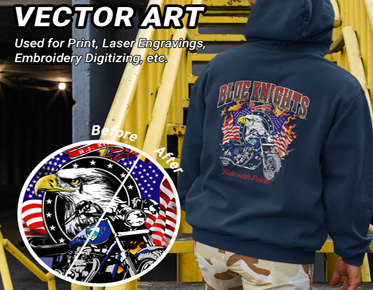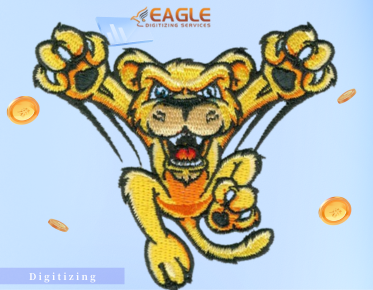Style Meets Identity: Logo Embroidery on Custom Apparel
The Appeal of Personalized Apparel
Personalized apparel has a unique charm that sets it apart from
off-the-shelf clothing. Custom logo embroidery
adds a personal touch, transforming simple garments into memorable pieces.
Whether it's for corporate uniforms, team gear, or promotional items, the
bespoke nature of embroidered apparel resonates
with wearers and onlookers alike, creating a lasting impression.
Why Logo Embroidery Stands Out
Logo embroidery stands out for its elegance and durability. Unlike
printed designs that can fade or peel over time,
embroidered logos are stitched directly into the fabric, ensuring they
withstand regular wear and washing. The texture and depth of embroidery also
lend a premium feel to the apparel, enhancing the perceived value and professionalism
of the brand.
The
Benefits of Custom Embroidered Apparel
Boosting Brand Visibility
Custom embroidered apparel is a powerful tool for boosting brand
visibility. When employees or customers wear clothing emblazoned with a company
logo, it creates numerous opportunities for brand exposure in everyday
settings. This consistent visibility helps to strengthen brand awareness and recall.
Enhancing Professional Image
Embroidered logos contribute to a polished and cohesive professional
image. Uniforms with embroidered branding convey a sense of unity and
professionalism, whether in a corporate, retail, or service environment. This
attention to detail can enhance customer perceptions and trust.
Durability and Longevity of
Embroidered Logos
Embroidered logos are known for their durability. The stitching
process ensures that designs remain intact and vibrant through repeated wear
and washing. This longevity makes embroidered apparel a worthwhile investment
for any business.
Cost-Effectiveness for
Businesses
While the initial cost of custom embroidery might be higher than other
branding methods, its long-term benefits outweigh the expense. The durability
and professional appearance of embroidered logos mean fewer replacements and a
better return on investment over time.
Choosing
the Right Apparel for Embroidery
Best Fabrics for Embroidery
Choosing the appropriate fabric is critical for successful embroidery.
Fabrics like cotton, polyester blends, and denim are ideal because they provide
a sturdy base for stitching. Softer, stretchy materials like jersey or thin
fabrics can be more challenging to embroider and may not hold up as well over
time.
Popular Apparel Choices:
T-Shirts, Caps, and More
T-shirts, caps, and polo shirts are popular choices for custom
embroidery due to their widespread use and versatility. Jackets, hoodies, and
bags also make excellent canvases for embroidered logos, providing additional
options for promoting your brand.
Considering Apparel Color and Style
The color and style of the apparel should complement your logo design.
Light-colored fabrics often work best with dark, bold embroidery, while darker
fabrics can make lighter threads pop. Additionally, consider the style and cut
of the garment to ensure it aligns with your brand's image and the preferences
of the intended wearers.
Designing
Your Custom Logo
Tips for Creating an
Eye-Catching Logo
An eye-catching logo should be simple, memorable, and versatile. Avoid
overly intricate designs that can become muddled when reduced in size for
embroidery. Clear lines and shapes, along with a balanced composition, ensure
your logo remains recognizable in various contexts.
Simplifying Complex Designs for
Embroidery
Embroidery inherently limits the level of detail that can be
reproduced. Simplify complex designs by focusing on essential elements and
avoiding small text or fine lines. This simplification ensures that your logo
remains legible and visually appealing when embroidered.
The Importance of Color
Selection
Color selection is vital in logo design. Choose colors that reflect
your brand identity and ensure good contrast between the logo and the fabric.
Consider how different thread colors will look on various apparel colors, and
test samples to find the best combinations.
Types
of Embroidery Stitches
Satin Stitches: Smooth and Shiny
Satin stitches are widely used in logo embroidery for their smooth,
shiny appearance. These stitches work best for outlining shapes and creating
bold, clean lines, giving the design a polished look.
Fill Stitches: Perfect for Large
Areas
Fill stitches are used to cover large areas with a dense, textured
pattern. They are ideal for filling in shapes and backgrounds, providing a
solid and durable embroidered surface that contrasts well with other stitch
types.
Outline Stitches: Adding
Definition and Detail
Outline stitches add definition and detail to embroidery designs. They are used to create borders, highlight specific areas, and
enhance the overall clarity of the logo. Common outline stitches include
running stitches and backstitches.
Selecting
the Right Embroidery Thread
Popular Thread Types and Their
Uses
Embroidery threads come in various types, each with specific uses.
Polyester threads are durable and colorfast, making them suitable for most
applications. Rayon threads offer a high sheen and are ideal for intricate
designs. Metallic threads add a touch of glamour but require careful handling.
Matching Thread Colors to Your
Logo
Choosing the right thread colors is essential for accurate logo
representation. Match the thread colors to your brand's official palette, and
consider how they will look on different fabric colors. Request thread samples
to ensure precise color matching.
Ensuring Thread Durability and
Quality
High-quality threads are crucial for durable embroidery. Invest in
reputable brands known for their strength and colorfastness. Poor-quality
threads can break easily and fade over time, compromising the appearance and longevity
of your embroidered apparel.
The
Embroidery Process Step-by-Step
From Design to Final Product
The embroidery process begins with the design and digitizing stages, followed by selecting the
appropriate threads and fabrics. The embroidery machine is then set up with the
digitized file, and the garment is hooped and
positioned. Once the machine starts, it stitches the design onto the fabric,
completing the transformation from concept to final product.
Key Equipment and Tools Used
Essential embroidery equipment includes the embroidery machine, hoops,
stabilizers, and threads. Additional tools like scissors, tweezers, and lint
rollers help maintain the quality and precision of the embroidery.
Quality Control Measures
Quality control is vital to ensure the final product meets the desired
standards. This involves inspecting the embroidered design for accuracy,
checking thread tensions, and making any necessary adjustments. Regular machine
maintenance and calibration also contribute to consistent quality.
Finding
the Right Embroidery Service
Key Factors to Consider When
Choosing a Provider
When selecting an embroidery service, consider factors such as
experience, reputation, and the quality of their previous work. Look for
providers who specialize in custom logo embroidery and can offer personalized
service and support.
Questions to Ask Potential
Embroidery Services
Ask potential providers about their digitizing process, turnaround
times, and pricing. Inquire about their quality control measures and request
samples of their work to assess their craftsmanship.
Comparing Costs and Turnaround
Times
Compare costs and turnaround times between providers to find the best
fit for your needs. Consider the value offered, not just the price, and ensure
the provider can meet your deadlines without compromising on quality.
DIY
Embroidery: Is It Worth It?
Pros and Cons of DIY Embroidery
DIY embroidery can be rewarding but comes with challenges. Pros
include creative control and potential cost savings. Cons involve the learning
curve, time investment, and the need for specialized equipment and materials.
Essential Equipment for Home
Embroidery
Home embroidery requires a reliable embroidery machine, quality
threads, hoops, stabilizers, and design software. Investing in good equipment
ensures better results and a more enjoyable experience.
Tips for Beginners
Beginners should start with simple designs and practice on scrap
fabric. Learning the basics of digitizing and experimenting with different
stitch types will help build skills and confidence.
Maintaining
and Caring for Embroidered Apparel
Washing and Drying Tips
Proper care is essential to maintain the quality of embroidered
apparel. Wash items inside out on a gentle cycle with mild detergent. Avoid
bleach and fabric softeners, and air dry or tumble dry on low heat to prevent
damage.
Storing Your Custom Apparel
Keep embroidered garments in a cool, dry location away from direct
sunlight. Folding them neatly or hanging them ensures they retain their shape
and appearance.
Repairing Minor Embroidery
Damage
Minor embroidery damage can often be repaired with a needle and
thread. For more significant issues, consult a professional embroiderer to
restore the design.
Trends
in Logo Embroidery
Innovative Techniques and Styles
Modern embroidery techniques include 3D puff embroidery, which adds
depth to designs, and appliqué, which combines fabric and stitching for a
unique look. These innovative styles keep embroidery fresh and exciting.
The Rise of Sustainable
Embroidery Practices
Sustainability is becoming increasingly important in embroidery. Using
eco-friendly threads, organic fabrics, and energy-efficient machines helps
reduce the environmental impact of custom embroidery.
Future Trends to Watch
Future trends in logo embroidery include the integration of smart
textiles and wearable technology. As these innovations evolve, they will offer
new possibilities for interactive and functional embroidered apparel.
Marketing
Your Brand with Custom Embroidered Apparel
Using Embroidered Apparel in
Marketing Campaigns
Incorporating embroidered apparel into marketing campaigns can enhance
brand visibility and customer engagement. Branded clothing serves as walking
advertisements, spreading your message wherever they go.
Leveraging Social Media to
Showcase Your Apparel
Social media platforms provide an excellent opportunity to showcase
your embroidered apparel. Share photos of your team wearing branded clothing,
post customer testimonials, and run contests to increase engagement.
Creating Employee Pride and
Unity
Embroidered uniforms and gear can foster a sense of pride and unity
among employees. When team members wear branded apparel, it reinforces their
connection to the company and promotes a cohesive, professional image.
Common
Mistakes to Avoid
Design and Color Pitfalls
Avoid overly intricate designs that don't translate well to
embroidery. Ensure good color contrast between the thread and fabric to
maintain logo visibility.
Overcomplicating Your Embroidery
Simplicity is key in embroidery. Complex designs with too many details
can become indistinct. Focus on clean, bold elements that stand out.
Choosing the Wrong Apparel or
Provider
Selecting the wrong type of apparel or an inexperienced provider can
result in poor-quality embroidery. Research and choose wisely to ensure the
best outcome for your custom apparel.
Cost
Considerations for Custom Embroidery
Breaking Down the Costs: Design,
Materials, Labor
Custom embroidery costs include design digitizing, materials like
threads and fabrics, and labor. Understanding these components helps in
budgeting and making informed decisions.
Budget-Friendly Tips for Small
Businesses
Small businesses can save costs by ordering in bulk, simplifying
designs, and selecting cost-effective materials. Building a long-term
relationship with a trusted embroidery provider can also lead to discounts and
better service.
Understanding Volume Discounts
Many embroidery services offer volume discounts for large orders.
Planning ahead and consolidating orders can help take advantage of these cost
savings, making custom embroidery more affordable.
FAQs
About Logo Embroidery
Addressing Common Concerns and
Questions
Common concerns about logo embroidery include the durability of the
stitches, color accuracy, and the ability to replicate complex designs.
High-quality threads and skilled digitizing ensure long-lasting and vibrant
embroidery.
Quick Tips for First-Time Buyers
First-time buyers should start with a clear and simple logo, choose
reputable providers, and request samples before committing to a large order.
Clear communication with the provider ensures expectations are met.
Custom embroidered apparel offers numerous benefits, from enhancing brand visibility and professional image to providing durable and cost-effective marketing solutions. And eagle digitizing provides embroidery digitizing services. The timeless appeal and versatility of embroidery make it a valuable investment for businesses of all sizes.
Investing in quality embroidery pays off in the
long run. Businesses should prioritize skilled providers and high-quality
materials to ensure their custom apparel stands out and makes a lasting
impression with the help of eagle digitizing's embroidery
digitizing services.


